Case Examples
Case Examples in Different Industries
Automotive
Oil distribution calculation in transmission
Courtesy of UNIVANCE CORPORATION
Simulating the behavior of oil that is stirred by the rotation of multiple gears and dispersed in the transmission.
In addition to measuring the amount of oil at the evaluation area, the torque on the shaft caused by the fluid force can also be evaluated.
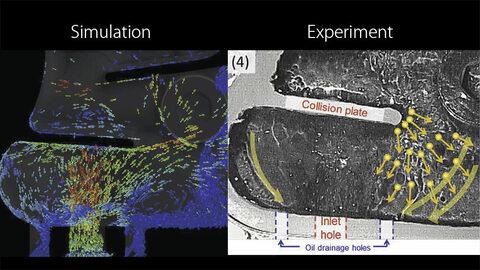
Simulation of Oil Separating Behavior for Engine Breather System
Courtesy of Honda R&D
Makoto HAGA et al. Honda R&D Technical Review Vol.26 No.2
Simulating the behavior of oil mist separation from the airflow in the breather chamber.
By comparing the results with the experimental visualization, the trends in oil dispersal and separation processes are qualitatively consistent.
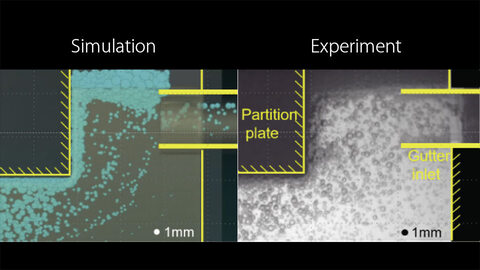
Studies on Particle Method Simulation of Bubble Behavior in Engine Lubricating Oil (First Report)
Courtesy of Honda R&D
Koji Matsui, Koichiro Matsushita et al. JSAE16 Spring season
Simulating the behavior of air bubbles inside an engine lubricant flow.
A correlation between simplified experiments and simulations of the bubbles’ movement and dissipation has been verified and a good correlation has been obtained.
Bubble generation analysis by gear oil stirring
Simulating the behavior of air bubbles which are generated by the rotation of gears and moved with the oil flow.
Simulation of water ingress into the vehicle running on flooded road
Particleworks × Recurdyn coupling
By coupling with RecurDyn, the motion of the vehicle’s suspension while driving on a flooded road can be also taken into account, which makes the evaluation more realistic.
*This model has been developed by The National Crash Analysis Center (NCAC) of The George Washington University under a contract with the FHWA and NHTSA of the US DOT
Simulation of water splashing
Particleworks × Recurdyn coupling
Simulating the behavior of liquid that is splashed up as the vehicle runs over puddles.
It allows to evaluate the impact point to the under the car body.
*This model has been developed by The National Crash Analysis Center (NCAC) of The George Washington University under a contract with the FHWA and NHTSA of the US DOT
Piston oil jet analysis
Above:Post-processing of vector view of the oil flow
Below:CG rendering based on the simulation result
Simulating the oil jet for cooling the piston head.
The oil jet impact point and the heat transfer coefficient are used to evaluate the cooling performance of the piston head.
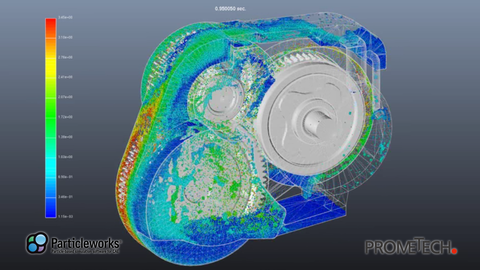
Powertrain Oil Sloshing Simulation
In this simulation, we can see how the engine oil behaves with three gears of different sizes and speeds, ranging from a differential gear with a diameter of about 20 cm and a speed of about 300 rpm to a drive gear with a speed of about 1000 rpm.
It is worth noting that you can see how the oil is scraped up by the gears and flows into from the top of the mechanism.
At the same time, you can see that the oil does not flow easily depending on the amount of oil and the location of the parts that block the flow path.
【Analysis conditions】
Region:50cm x 30cm x 40cm
Event time:11 seconds
*Movie speed is about ½
Total number of particles : About 500,000
Above:The liquid is shown as particles view and the flow velocity is shown as contour view
Below:CG rendering based on the simulation result
Fuel tank sloshing
Simulating the fuel behavior in the fuel tank by applying an external force acceleration which is assuming vehicle driving.
By comparing the fuel behavior with and without the baffle plate, we can evaluate the effect.
Fuel spill analysis during refueling
(Gas-liquid two-phase flow analysis)
By coupling the airflow analysis function using the Finite Volume Method (FVM) with liquid analysis using MPS, gas-liquid two-phase flow can be efficiently analyzed. When refueling, the inner air is removed from the tank by the breather tube. In this simulation, we can see that when the refueling flow rate increases, the air couldn’t be removed and the fuel flows backwards.
Simulation of oil behavior in a planetary gear system
Simulating the oil behavior in a planetary gear system with complex rotational motion.
The oil is stirred up by the rotation of the planetary gears and can be seen spreading throughout the gear equipment.
It would be possible to evaluate whether a sufficient amount of oil is lubricating the area of interest.
Simulation of oil lubrication in a ball bearing
Simulating the behavior of oil into a rotating ball bearing. It would be possible to evaluate whether the inside of the bearing is sufficiently lubricated with oil.
Electric Appliances & Machinery
Oil injection analysis to the motor
Comparing the oil behavior after impact with the coil end, by changing the oil injection method.
The cooling performance of the motor can be evaluated by outputting the heat transfer coefficient of oil flowing across the coil end surface.
Oil cooling analysis of oil cooled motors
Simulating the behavior of the motor cooling oil after impact with the coil ends.
It is shown that the oil cools the coil end and the temperature drops.
By using this, efficient oil cooling methods can be investigated.
Iron/steel & Metals
Water flow in continuous casting rolls
Image courtesy of Nippon Steel & Sumitomo Metal Corporation
Simulating the behavior of the water spray for cooling in the steel continuous casting process.
Cooling spray is placed between the rolls that support the solidified pieces of the cast, and the cooling inhomogeneity depending on the rolls and spray placement is evaluated.
*CG rendering based on the simulation result
Twin-screw injection molding
Image courtesy of Japan Steel Works, Ltd
【Analysis conditions】
Material properties :
Density:Water>1000kg/m^3
Kinematic viscosity:5e-2m^2/s
Surface tension:off
DF moving condition (Screw rotational speed)
Screw:30rpm
Particle size : 2.5mm
Particle modeling :
Total number of particles : About 70000 for max
Simulating the behavior of high-viscosity fluids extruded from the twin-screw and visualizing the mixing state.
It is possible to compare the behavior of different shapes and extrusion conditions.
Below:CG rendering based on the simulation result
Fluid-rigid body coupling for simulating scrap metal flushing
Simulating the behavior of metal debris which is modeled with rigid particles and pushed away by a fluid.
*CG rendering based on the simulation result
Materials
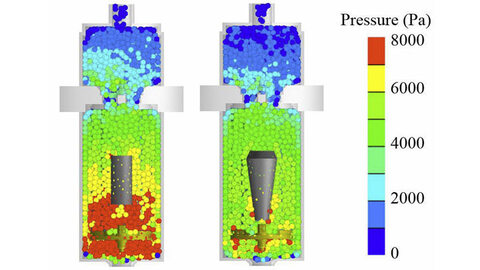
Shape Optimization of Filter System using Fluid Analysis Based on MPS Particle Method
Courtesy of ROKA SEIKO CO., Ltd.
The Japan Society of Mechanical Engineers (OPTIS2016)
Particleworks and Optimus an optimization software tool were used to optimize the geometry of a filtration system to maximize the effective filter area.
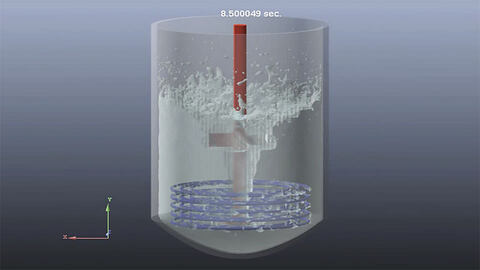
Vortex in stirring tank
Image courtesy of Mitsubishi Chemical Corporation
Powder-Liquid Mixing in a Planetary mixer
Simulating the behavior of powder and liquid being mixed by a planetary mixer. By using powders, which have lower specific gravity than liquid particles, we can observe that the powders floating in the liquid are stirred and mixed by the planetary mixer.
A liquid containing powders (powder-liquid mixed phase flow: slurry flow) is used for abrasives, etc. The higher the concentration of powders, the higher the apparent viscosity.
The Discrete Element Method (or Discrete Element Method (DEM)) is a method for simulating the behavior of these powders numerically. It tracks the behavior of powder particles, taking into account collisions between particles or between particles and the wall, and friction during collisions.
*A separate Granuleworks license is required for the coupling of Particleworks (MPS) and Discrete Element Method.
High-viscosity mixing with triple impellers
Plastic and rubber materials are used in many industrial products for their excellent molding and processing properties. These materials are highly viscous, and if air is sucked into them during the manufacturing process, it is difficult to release the air, and if they harden in this state, the original properties of the material may be lost.
For this reason, air is removed by agitation, or in other words, defoaming is performed. In this simulation, the stirring of a high-viscosity liquid with three agitating blades that are rotating in opposite directions is evaluated. The particle method is stable for such a high-viscosity flow and requires only a small number of calculations.
*CG rendering based on the simulation result
Tank sloshing simulation
(Velocity vectors and a rendered image)
Simulating the liquid behavior inside the tank when it is shaken.
We can see the complex changes in the free surface are captured and the pressure on the inner wall of the tank can also be determined.
Ver7.0 new function : Conjugate heat transfer analysis
In a mold cooling analysis, heat transfer between the product and the cooling water (fluid) and the mold (structure) can be simulated. Not only the temperature change of the particles, but also the temperature change of the mold (structure) can be confirmed by the cross-sectional contour view.
Paddle Kneader: Kneading and Dispersion of Powders and Fluids
Granuleworks × Particleworks coupling
Here is a process of moisture control of powder using a paddle kneader. High-viscosity liquid is added while the powder is stirred, and it is shown how the liquid is evenly mixed with the powder. Dispersion of the liquid into the powder is a difficult operation, but the result of this simulation also shows that the liquid does not disperse sufficiently, resulting in adhesion of the liquid to the wall.
Above:Evaluating thermal distribution, fluid distribution, mixing index, etc.
Below:CG rendering based on the simulation result
Application to rubber kneader
Rubber kneading machines are required to mix rubber materials and compounding/filler agents uniformly in a short time. In this simulation, we visualize the kneading process and evaluate its behavior, by using Particleworks.
Food & Consumer Goods
Coffee cup sloshing
Simulating the behavior of the coffee when the cup is vibrated.
It can be observed that the behavior of the coffee overflows differently depending on the shape of the lid.
Dishing machine analysis
Simulating how the stains on the dishes are removed when the water stream impacts.
The spray conditions and other factors can be studied.
Stain removal of tile surfaces with a high-pressure washer
Simulating the removal of dirt from tile surfaces with high-pressure washer.
The jetting conditions and other factors can be studied.
Paint application
Simulating the paint application sprayed from a nozzle. Depending on the shape of the nozzle, the thickness, width, etc. of the applied paint can be studied.
Medical & Pharmaceutical
Coming Soon……
Civil Engineering
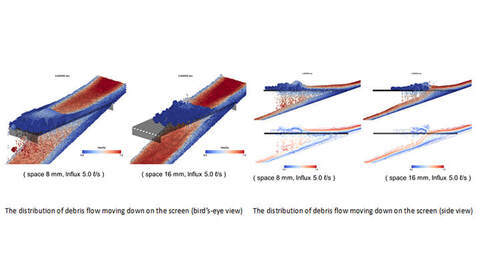
Debris flow simulation on the debris flow breaker
by coupled analysis of rigid body and fluid
Disaster risk reduction Planning Workshop, NPO, Tokyo, Japan
Hajime Ikeda, Takanori Ito
Energy & Power
Turbulent flow simulation by Particle-based Method
Turbulence is a flow with vortices that varies irregularly in time and space, which requires a very high spatial resolution (on the order of 9/4th power of Reynolds number for lattice methods) to be solved directly using numerical methods for such turbulent phenomena.
Therefore, a mathematical model with spatial or temporal averaging (turbulence model) is used to solve engineering problems.
Turbulence analysis in the particle method also uses a turbulent model. This shows the results of simulated turbulence behind a cubic-shaped obstacle. Vortices, etc., generated behind the obstacle can be observed.
